|
Neuroscientist Adrian Owen uses brain scans to communicate
with patients in a post-coma, locked-in vegetative state. This is a first.
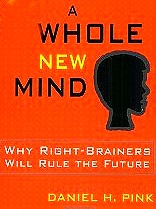
Spark up your right brain. With the workplace
again in flux, Daniel Pink writes that success will shift to people who possess
strong right brain qualities. In his
latest book, "A Whole New Mind: Why Right Brains Will Rule the Future," Pink defines the skill
sets we can harnessed
effectively in the new "Conceptual Age." He discusses the six
essential aptitudes we'll need to progress in personal satisfaction and
professional advancement.
Some history: for a
century Western society has been dominated by a form of thinking and an
approach to life that is narrowly reductive and analytical. It has been an age
of the "knowledge worker," the well-educated expert manipulator of
information. Now we're entering a new time animated by a different form of
thinking and new approaches to life.
High-concept
thinking involves the capacity to detect patterns and combine seemingly
unrelated ideas into something new. High-touch involves empathizing with
others, understanding the subtleties of human interaction, and stretching
beyond the quotidian in pursuit of pleasure and meaning. Although we use
both
hemispheres of our brains, Pink believes that we need to develop our right
brains to thrive in an entirely new environment. It has the necessary qualities of
inventiveness, empathy, joyfulness, and meaning that will increasingly determine who
flourishes and who flounders.
Pink's book is
provocative and timely. Harvard Business Review named him one of the top 50
business thinkers in the world. His best-selling "A Whole New Mind and
Drive" has been published in 34 languages.
more on A Whole New Mind
go to Pinker
"Learnng is my utopia."
- Helen Keller
What's the state of neuroscience?
The brain is fascinating because we know so much about it.
But we don't understand what we know. Yet.
Where and why does creative talent cluster?
New ideas move economic growth. From where do these ideas emanate?
Statistician David Banks found that geniuses aren't scattered randomly over time and space--
but instead, are found in tight clusters.
The term "meta-idea" was coined by economist Paul
Romer. He offers the examples of ideas behind the patent system, public libraries and universal education.
There is a 'clotting' of creative talent. Meta-ideas support the
spread of other ideas. There are times and places of "excess genius," e.g. Athens in the 5th century B.C., and Florence in
the 15th century. Past clusters like these occurred in commercial trading centers where a wide diversity of people shared
ideas.
Urbanization and density of intellectual interaction, as well as
education itself, are impelling factors in the phenomenon of clusters.
Open immigration is another. For example, in an overall population,
a one-percent increase in the number of immigrants with college degrees leads to a 10-20 percent increase in patent production,
i.e. new ideas.
In mideaval Florence there were guilds and apprentice-master traditions.
In Elizabethan England, education spread to its middle class-- which
is how William Shakespeare, son of a glove-maker, got free Latin lessons.
America has been a great generator of geniuses.
Problem is that today most of these are athletes. Young athletes are treated well by family and communities. We have
mechanisms for cultivating athletetic talent at every step of the process, from Little Leagfue to the Majors.
America has never needed "excess genius" more than now. But it won't
happen by accident. The atmosphere and opportunities need to be constantly cultivated.
Many of our cities are embryotic but hold possibilities for
great minds to 'mix it up,' bolstered by enlightened city design, investment, and institutional receptiveness. Our position
in the global 'community' demands it. Our survival as a world leader requires it.
The great ages did not contain more talent; they wasted less."
-T.S. Eliot
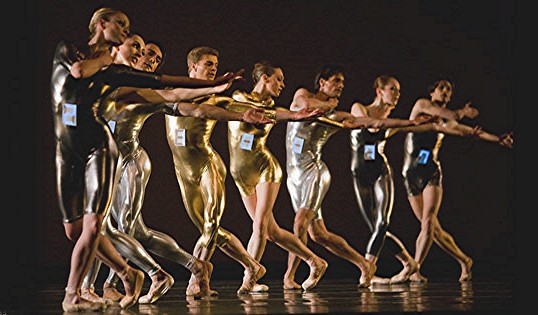
|
| Brain Dancing. Photo: Erik Tomasson. |
Dance: Our Basic Instinct
The neural choreography of dance is a primal human expression. One brain
area helps us navigate through space; another synchronizes our pace and actions... for an instant confluence of movement,
rhythm, and gestures.
It is an evolutionary novelty among us humans to
unconsciously tap our feet or fingers or sway with a musical beat. New imaging studies explain why.
Dancers lie flat in the PET scanner and have room
to move their legs along an inclined surface. They hear music through headphones and do box and tango steps as directed.
Scans light up toward the back of their brains in the precuneus parietal lobe– very close to the kinesthetic link to
the legs. At the same time sensory organs in the muscles provide feedback giving the body’s exact orientation in space
via nerves passing through the spinal cord to the cerebral cortex.
A key finding is the importance of visualization.
The ability to rehearse a movement in our minds is vital to learning motor skills. Anyone who has worked on their golf swing
or tennis serve or high dive is familiar with this phenomena. True mastery requires a muscle sense, and a motor image in the
brain’s motion-planning areas. Tiger Woods has that one nailed.
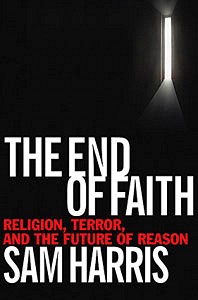
Sam Harris studies
religious traditions and spiritual disciplines, and is the best-seller author of "The End of Faith"
and "Letter to a Christian Nation." Regarding the clash of faith and reason, he says "The
kind of intolerance of faith that I am advocating in my book is not the intolerance that gave us the gulag. It is conversational
intolerance."
go to Sam Harris Blog
Sam Harris excerpted comments on the "God-Drunk
Society" in The Atlantic's special edition "The American Idea:" "As Islamic medievalism threatens civil society in a hundred countries, America
could easily unite her erstwhile allies in defense of reason. We could also lead the world in wise environmental policies,
scientific education, medical research, aid to developing countries, and every other project relevant to the durable welfare
of humanity. "Instead, we devote our national conversation to pious phantasmagoria like intelligent
design, school prayer, and the problem of gay marriage. We elect legislators who speak with terrifying certainty about an
imaginary deity, and with disgraceful ignorance about established science. "This must change. America is now the world's lone superpower. If the idea of "America" is to mean anything at all,
Americans have a moral responsibility to become citizens of the 21st century."
go to Project Reason
Soon "Mind Reading" will be for real.
A team of scientists at UCB, led by Robert Knight, have programmed
computers to decode brain waves and replay them as words. Really!
The possibilities are immense: a paralyzed person could 'speak.' Doctors
could access the mind of a patient in a coma. (Theoretically, you could rewatch your dreams on an iPad-- or whatever gizmo
you'll use in the future.)
Jack Gallant led another test that showed colleagues movie trailers
and used computers to play back in color what people saw. Really!
The science of 'decoding' could not only reveal the movies in our minds but eavesdrop on what we hear.
Current methods are still in the very early stages and progress is
being held up by clunky machinery like the MRI. Gallant sayt that leaps into the human mind, which now seem incredible, will
reach state of the art in about 30 years. Meanwhile, neuroscientists are beginning to unlock the secrets of our memories and
consciousness.
go to U.C. Berkeley movies
go to Berkeley News Center
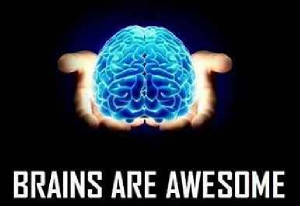
Exceptional mind found in a physically
'normal' brain. Perhaps the best example of this is with
Albert Einstein, who donated his brain to science. His brain was removed before Einstein's cremation
upon his death in 1955-- and carefully studied by many of the world's experts, section by section, part by part. His brain weighed 40 ounces-- lighter than most.
No significant differences were found from other men of his age. No sections were more developed than average. We can happily conclude that the source of genius
may not lie in the physical structure of our brain, but rather in its functioning. That's good news for those of us who
feel that we have a bit of genius within us. We most probably do.
|
"Contradiction is what keeps sanity in place."
- Gustave Flaubert
"Morality must relate at some level to the well-being
of conscious creatures."
- Sam Harris |
"None are more hopelessly enslaved than those who falsely believe they are free."
- Johann Wolfgang von Goethe
"The universe is not required to be in perfect harmony
with human aspirations."
- Carl Sagan
"If a nation expected to be ignorant and free, it expected
the impossible."
- Thomas Jefferson
|
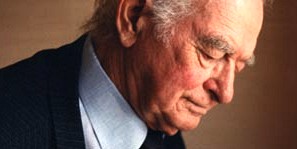
|
| Linus Pauling (1901-1994) |
Linus Pauling
is the only person who has won two unshared Nobel Prizes-- for Peace, and for Chemistry. In 1963 he predicted that it would
one day become possible to reconstruct extinct forms of life. Turns out he was right.
Brainpower in the new field of Evolutionary Biology is
uncovering surprising marvels. Research has altered the phylogenetic tree. It is now possible to reconstruct infectious progenitors
of viruses.
Viruses, you say? Yes. Molecular biologists and biochemists are dealing
with viruses that are millions of years old. Charles Darwin would be amazed to know how integral viruses are to the evolution
of our species.
Biologist Harmit Malik says "We have been
in an evolutionary arms race with viruses for at least a hundred milion years. That's evolution. It's the world's version
of cat and mouse. Viruses evolve, the host-adapter proteins change and viruses evade them. It never ends."
Luis P. Villarreal, who heads the Center
for Virus Research at UC Irvine, says "Viruses may well be the unseen creator that most likely contributed to making
us human."
"I have always liked working in some scientific direction
that nobody else is working in."
- Linus
Pauling
Four hundred years alo Galileo Galilei got his first
look through his telescope lens into space.
Galileo was a cosmic detective who envisioned and created the first
telescope. He opened up our world. His inventive leap in scientific knowledge revealed to us the great galaxies and limitless
solar systems of the universe beyond.
The International Year of Astronomy, celebrating
Galileo, began in Paris, under the aegis of UNESCO. There were events in 140 countries
and every major observatory offered special attractions: sky outings, cosmic diaries, and astronomy marathons. Advances in
the four centuries since Galileos first telescope in 1609 are astounding. In 2009 the world was starry-eyed.
For more info:
How gullible are we?
Pop psychology can send us off-track with misinformation.
Here are 10 examples:
- It's better to express anger than hold it in.
- Low self-esteem cause psychological problems.
- Human memory works like a video camera.
- Hypnosis is a trance.
- Polygraph tests accurately detect lies.
- Opposites attract.
- We only use ten percent of our brains.
- Schizophreniacs have multiple personalities.
- Full moons cause crimes and madness.
- Insanity is a common criminal defense.
All the above: not true.
For shaking these and other mind myths, check out the Skeptic Society.
go to the Skeptic: Promoting Science and Critical Thinking

Get answers to basic questions about everyday science:
go to How Stuff Works
AS
YOU READ THIS-- your brain is alive with activity-- directing the movement of your eyes, decoding
the electrical impulses from your retina, recognizing the pattern of words in these sentences and extracting their meaning,
as well as controlling your breathing, heart rate, and body temperature, adjusting your posture, screening out the buzz of
background stimuli, and performing countless other tasks, volutary and not.
It controls what we hear, feel, see, and think-- everything
that goes on inside our bodies and all the interactions we have with the outside world. It makes us capable of making breathtaking
athletic feats, sublime works of art, and profound scientific insights. Perhaps its most amazing achievement
is that it is now trying to understand itself.

|
| Vassar Street entrance of the BCS Complex. Photo: Bob O'Connor |
The
Brain and Cognitive Sciences (BCS) Complex at MIT is the world's largest
neuroscience research center. It includes the Althinoula A. Martinos Center of Biomedical Imaging and the Picower Institute.
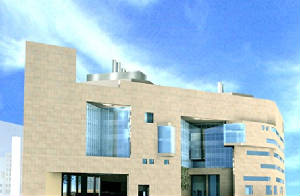
|
| The BCS. Goody and Clancy, architects. |
"Humility constitutes the best point
of departure in the search for truth."
- Michaelangelo Antonioni, film director.
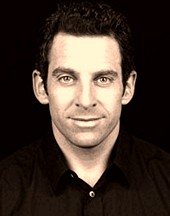
|
| Sam Harris |
Sam Harris started Project Reason to spread
scientific knowledge and erode the influence of dogmatism, superstition, and bigotry. It draws on the talents of prominent
and creative thinkers in a wide range of disciplines, including neuroscience, law, literature, film, journalism, and information
technology.
In his latest book, "The Moral Landscape: Thinking
About Human Values in Universal Terms." he casts new light on the age-old questions of right and wrong, good and evil.
go to Sam Harris book-tour talk on "the Moral Landscape"
University of California at Los Angeles is
a top research center on mindful awareness. Listen to or download mp3 guides to meditation.
go to UCLA Mindful Awareness Research Center
RETREAT INTO SILENCE:
Comtemplating Contemplation
When Sam Harris went to the Insight Meditation Society's
Retreat Center in rural Massachusetts with 100 top scientists-- there was no talking, no writing,
and no eye contact for the first six days. The rest of the time was spent discussing the experience of silent meditation known
as vapassana (the Pali word for 'seeing clearly.'
In the Western world, thinking incessantly, speaking all day long,
and multi-tasking is the norm. Most of us are caught up in the busy-brain syndrome. We 'left-brain it' day after day
and soon get out of balance. From the Buddhist's view, it is a kind of madness.
A growing body of research suggests that meditation can produce profound
insights into the nature of human subjectivity which has a direct bearing upon our ethics and level of happiness. The
retreat was the first time a large group of scientists sought to personally test such claims. At long last, we're on the frontier.
It's a start.
go to Sam Harris retreat diary
Sam's recommendations for further study:
go to Spirit Rock

|
| Earth's Magnetic Field. Click to enlarge. |
go to the Milky Way and Andromeda Galaxies on their collision courses
go to stargaze on Google
Want a cure for brain flab, dumb news, out-of-context fads, and outrageous
opinions? Try the Nature Journal's "Science on Your Desktop"
go to Nature Journal
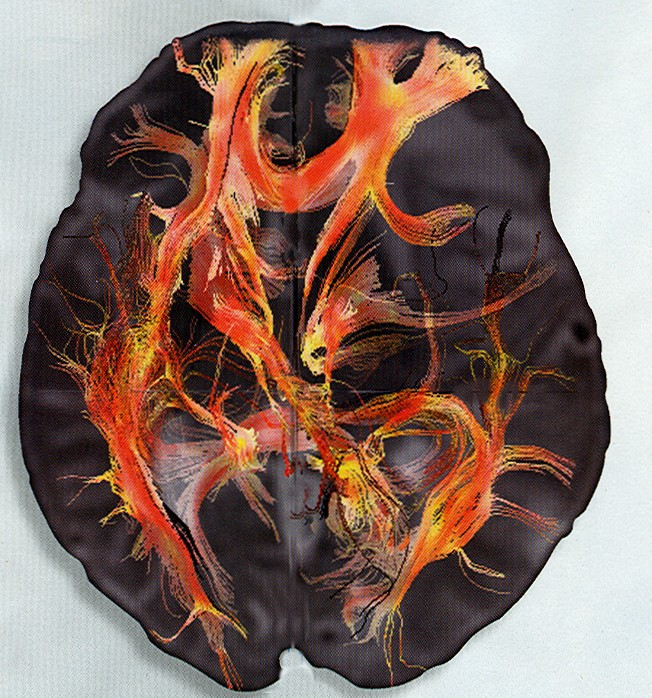
|
| New MR system is a powerful magnet that captures images of brain activity. It can 'read' your mind. |
The energy consumption of our brain is equal to a 20
watt light bulb.
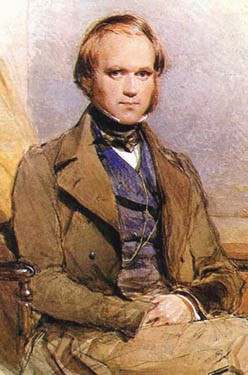
|
| Darwin at 31. George Richmond painting. |
The 200th anniversary of Charles Darwin's birth is being
celebrated at more than 500 events in 38 countries.
go to Darwin Festival at Cambridge
go to John Templeton Foundation
"I was born a naturalist."
- Charles Darwin
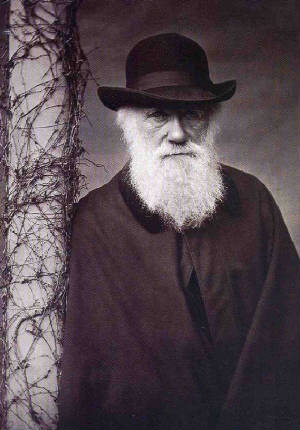
|
| Darwin at 82. Photo: Julia Margarete Cameron. |
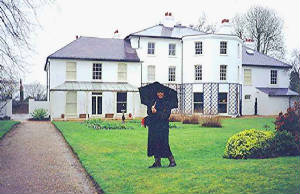
|
| Editor at Darwin's home, Down House, in Downe, England, near London, in 1999. |
"This
is the end of the sixties idea that revolution is around the corner. People now know it's not. It's in their kitchen. It's
in their footsteps, in the choices they make to buy this and not that."
- Bono
"The brain is wider than the sky."
- Emily Dickinson
"Never compromise yourself.
You are all you've got."
- Betty Ford
"Injustice anywhere is a threat to justice everywhere."
- Martin Luther King Jr., from "Letter
From Birmingham Jail."
"The trouble with the world is that the stupid are cock-sure
and the intelligent full of doubts."
- Bertrand Russell
The Nobel Prize organization in Stockholm
has a fine web page-- with everything you ever wanted to know about the prize and award winners: bios, photos, video clips,
articles, lectures, and interviews.
go to the Nobel Prize organization
Venture to fine web links celebrating physics:
go to the World Year of Physics ("WYP2005")
go to Einstein's manuscripts and archival database of 43,000 items
go to American Institute of Physics on "WYP2005"
go to NOVA program "Einstein Revealed"
go to The Miraculous Year Exhibit Rueben H. Fleet Science Center, San Diego
|
 |
 |
 |
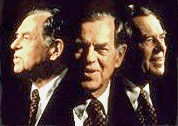
|
| Mythologist Joseph Campbell |
"We must be willing to get rid of the life we've planned so as to have the life that is waiting for us."
- Joseph Campbell
" The priest presents for consideration a compound of inherited forms with the expectation (or,
at times, even requirement) that one should interpret and experience them in a certain authorized way. Whereas the artist
has a personal experience, and then seeks to interpret and communicate through effective forms. Not the forms and then the
experience, rather the experience first, and then the forms.
"Who will be touched by these forms and be moved by them to an experience of one's own? By what magic can
a personal experience be communicated to another? And who is going to listen?"
- Joseph Campbell
The honored author and master teacher of mythology, Joseph
Campbell, is really not getting his due in the documentary film "Finding Joe." A better story will come.

Losing sleep over it?
More than 30 percent of medical problems that doctors are faced with
stem directly or indirectly from sleep. Yet sleep has been ignored in medical schools and there are few research centers on
the subject.
Without solid knowledge people panic when they don't get enough sleep--
making matters worse.
Circadian neuroscientists now say that the need for eight
hours of uninterrupted sleep is a myth.
What's gone so wrong in our Ambien world?
Most doctors don't know that a solid eight-hour night's sleep may be
unnatural.
So they write prescriptions.
But let's realize that we are like our distant ancestors. And, according to sleep psychologist Gregg
Jacobs, throughout time we humans have slept in a certain way-- and that has included waking up during the night. He
says that's normal.
Even though our lives are so very different from people in pre-industrial times-- without electricity, entertainment
centers and iPhones-- our sleep physiology remains the same. Our brains share the same elementary biology.
Russell Foster is a professor of circadian (body clock) neuroscience at Oxford.
He says that we 'modern' sleepers are experiencing a 'throwback to the bi-modal sleep pattern' of eons past.
He has found that the typical pattern of shut-eye isn't actually eight uninterrupted hours, but rather two
sets of four hours. So lying awake may be good for you.
Essentially, most of us have similar sleep patterns-- and it's not a consolidated block. We have a waking
period between sleeps, a time which plays an important part in our capacity to regulate stress naturally.
In historical accounts, people used their 'wake-up'time to meditate on their dreams. We rarely do this.
Instead, what is a normal waking period causes us stress. People who suffer from anxiety, depression, alcoholism
and drug abuse often blame their problems on lack of sleep. Perhaps it's just a lack of understanding sleep.
go to Myth of Sleep
go to Science of Sleep
go to Teenage Sleep
go to Improve Your Sleep

|
| Kids love it. Click to enlarge. |
If it's a bore it's not play.
Goodbye 'jungle gyms' and playgrounds that
stifle imaginations and a child's need for free play.
Stereotypical playground equipment is a bore. Moveable
objects invite mindful play that lets kids experiment, build, and come up with their own ideas.
Let the play begin.
Most U.S. playgrounds have jungle gyms in brightly colored and
indestructible frame structures that are safe, unchallenging, and achingly boring.
For 75 years the model for city playgrounds
was the "four S’s: swing, sandbox, seesaw, and slide. The parks were designed by and for adults who are interested
in orderliness and safety. Their notions have nothing to do with children’s play.
Kids like to be messy and have adventures. A child might open
a perfectly wrapped gift toy and start playing with the box it came in withe the Styrofoam peanuts. Play isn’t static.
To date there are more real places for play in Europe, where designers
‘get it.’ In England, Lady Allen of Hurtwood is a prominent architect and president
of the World Organization for Early childhood Education. After a recent tour of American showpiece playgrounds, she observed
that they were ‘an administer’s heaven and a child’s hell.’
(Playgrounds have traditionally been regarded as places where
children, by playing, learn to become non-playing adults.)
In 1945 Lady Allen visited Copenhagen to see a wildly popular
playground stocked with building materials. Back home in London she started a movement to take over old bomb sites and equip
them in a similar way. They were kid magnets. Now there are 28 adventure playgrounds in England, and dozens more in Sweden,
Denmark, and Switzerland.
Insurance conscious Americans argue that boards and bricks are
dangerous playthings. Lady Allen counters that accidents are less frequent in her playgrounds than in conventional asphalt
lots... ‘probably because immovable playthings frustrate children and breed a sort of mass hysteria.’ She adds
‘better ro risk a broken bone than a broken spirit.’
Architect Simon Nicholson invented the term ‘loose parts’
in an influential essay "How Not to Cheat Children: The Theory of Loose Parts."
He wrote ‘In any environment, both the degree of inventiveness
and creativity, and the possibility of discovery, are directly proportioned to the number and kind of variables in it."
New York architect David Rockwell
was disheartened-- when he took his offspring to a nearby playground– by such constricted opportunities for play. He
was nostalgic about the free play of his youth and wished his children had access to that experience.
He got busy designing an adventure playground– multilevel
with water and sand and loose parts ready for deployment. It was built on a former parking lot and has big light-weight blocks
made from bright blue molded foam– with all kinds of holes, noodles, and tunnels. Other bits of playable hardware are
wooden wheelbarrows, car tires, plastic barrels, brooms, etc. objects that invite building something from scratch.
Kaboom is marketing "Imagination
Playground in a Box," pulling strong demand from park departments, child-care centers, elementary schools, and children’s
museums.
Darrell Hammond, Kaboom’s CEO, syas that when the boxes
are first opened on a playground it’s not unusual for kids to spend the first 20 minutes whacking one another with the
noodles.
Time to banish the monkey bars. Frank Gehry is designing a playground for Battery Park that will be big on drama and fantasy.
Dozens of novel play spaces are on architect’s drawing boards. Let the fun begin!
| "Loose Parts" |
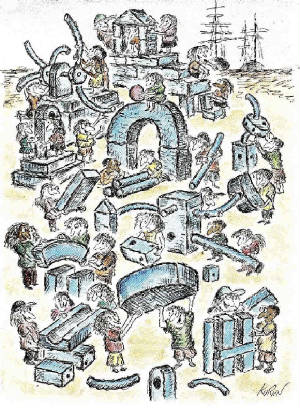
|
| Zachary Kanin, The New Yorker. |
Imaginative play is necessary for the development of a child's mind.
go to The Imagination Playground
more on the Playground Movement
How we're wired for pleasure:
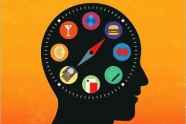
|
| Compass of Pleasure |
Following his last book, "The Accidental Mind,"
neuroscientist David J. Linden has written "The Compass of Pleasure."
It's a tour of the reward pathways in the brain. Reading it explains our yens and addictions that originate in those
pleasure points. Chocolate, anyone?
The subtitle says a lot: "How our brains make fatty foods, orgasms,
exercise, marijuana, generosity, vodka, learning, and gambling feel so good."
Linden is a professor of neuroscience at the Johns Hopkins University
School of Medicine. His lab has worked for years on the cellular substrates of memory storage in the brain. He is also the
Editor of the Journal of Neurophysiology.
go to David's Blog
It's getting harder and harder to think.
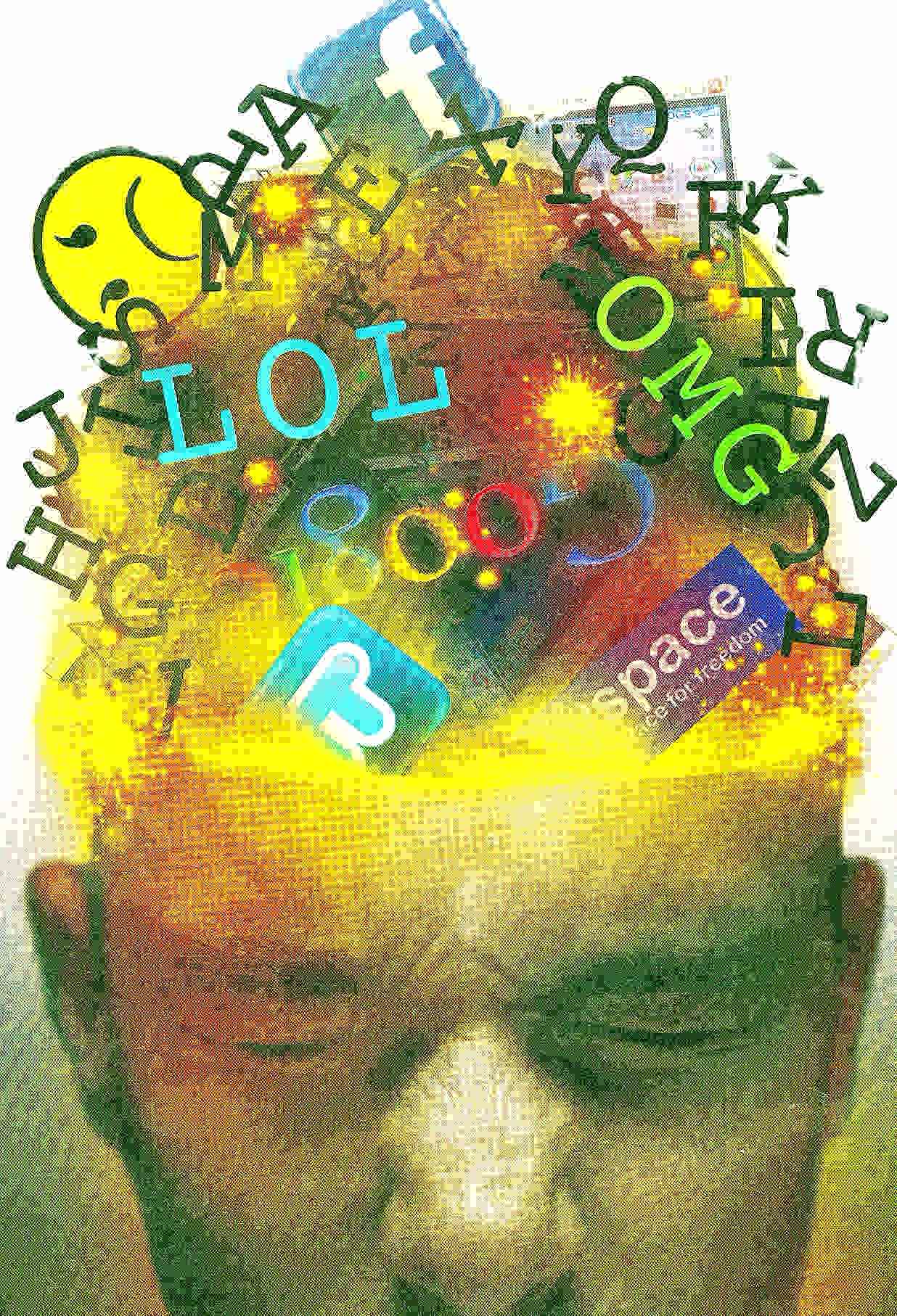
|
| illustration: Matt Mahurin |
Our tweeting and blog-worn universe.
Incoming-text, cognitive overload, squeezed time, juggled
tasks, and option overflows can produce ‘brain freeze,’ a type of mental paralysis. Excess data bombards our brains-- and the surfeit is changing the way we think.
That makes it more difficult to make well-informed, successful
decisions.
In the field of Decision Science,
studies show how awareness is dulled when information never stops arriving. Increasing the options can produce debilitation.
Getting caught up in information onslaughts can lead to
unfortunate choices, mistakes, or failure to make any decision. There comes a point where we actually know too much to act.
We need to be aware and honor the limited capacity of our
brain’s working memory– which holds about seven ideas at a time. Anything more must be processed into long-term
memory, which takes a conscious effort.
Sheena Iyengar, author
of "The Art of Choosing," says "When we make decisions, we compare bundles of information. So a decision is harder if the
amount of information you have to juggle is greater."
Joanne Cantor, author
of "Conquer Cyber Overload," reminds us that our brains are constantly trying to figure out what to keep and what to disregard.
Our growing demand for immediacy overloads our brain at the cost of accuracy and thoughtfulness.
Conditioned as we are to the ‘latest thing,’
we sacrifice what’s more valuable and interesting. Psychologist Maarten Bos explains, "When
we default to the conscious system we often make poorer choices.
Eric Kessler, at Pace
University, adds "What starts driving decisions is the urgent rather than the important. The result is that we may regret
decisions made during an info-deluge. It’s better to make intuitive decisions which rely on our distilled expertise
that flows when our subconscious system kicks in." Or, as our ancestors advised, "sleep on it."
In testing, researchers call people who know when enough
info is enough ‘sufficers,’ and those who never stop surfing, devouring, and struggling ‘maximizers.’
It’s clear that sufficers make the better decisions.
The tidal wave of electronic thrusts at trigger speed has
resulted in attention deficits, compulsive behavior, exhaustion, anxiety disorders and prescription drug use of epic proportions.
If we are
to regain confidence in our decisions we need to reconnect to our intuition, and know when to say ‘I have all the relevant
and important information, and that’s enough!’
go to James Gleick and his book "The Information"
go to Sheena Iyengar on "The Art of Choosing" on TED Global video
The
Angry Voter
Drew Westen, author of "The Political Brain," talks about anxiety morphing into anger. "Gut-level feelings of tremendous anxiety
quickly turn into rage. Men in particular don’t like feeling anxious, so they very quickly convert anxiety to anger
at what made them anxious.
"There is a strong element of nihilism
in this–- an attitude of 'I don’t care if the experts say some policy will be a disaster or some candidate is
a lunatic. Things are already so bad, can they really get much worse?’"
Psychology professor George Marcus
(Williams College) says "Angry voters aren’t interested in objective information, but only in the kind that reinforcers
what they believe."
George Lakoff, author of "The Political Mind," says "People tend to adapt their baseline expectations to what they already have."
Ronald Pies wrote in "Psychiatric
Times," that there is a ‘magical’ dimension to intense anger. "It transforms the world from one in which
the person feels helpless and impotent into one in which the person has the illusion of power and control.
It is as if to say ‘If I get angry enough, the laws of physics
won’t apply– I’ll be able to plug that damn oil leak through the power of my righteous indignation."
Political Scientist Hank Jenkins-Smith
says "People have a great capacity to engage in what’s called motivated reasoning. If they
have strongly held beliefs with an emotional component, their brain defends information that reinforces those ‘priors’
and is skeptical of information that challenges them.
"The more that issues are explained in neutral forums
the more people’s beliefs are cemented. People who hold these hard ‘priors’ filter information to support
their perceptions.
"If any diehard rationalists still believe that
voters are driven by logic more than emotion, elections will set them straight."
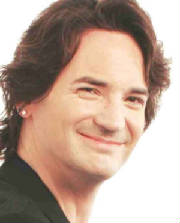
|
| Doug Merrill |
Suffering from TMI overload and multitasking meltdown?
Get real. The human brain was not
designed to hold such monumentlly crazy arrays of 'stuff."
Give it a break. Live clutter free. So says Douglas
C. Merrill, the former Chief Intelligence Officer (CIO) of Google. As a dyslexic he's happy to let computers do the
heavy lifting-- and he's encylopedic about short-cuts and time-savers.
So he wrote a book about it: "Getting Organized
in the Google Era: How to Get Stuff Out of Your Head, Find it When You Need it, and Get it Done Right." (Random House, 2010)
He devotes a chapter on how to be a savvy user of search engines--
to zero in quickly on what we need to know. Do you know these tricks? Do you use tilde symbols? Check it out.
more inside tips on Google searches

|
| Nicholas Carr |
What’s your internet anxiety level? How are you reconciling
your humanity with the frenetic march of technology?
Nicholas Carr, author of "The Shallows: What the
Internet is Doing to Our Minds," says that failing to focus and succumbing to digital distraction can make you loose
your mind and become a chronic scatterbrain. Some think he has written a "Silent Spring" for the literary mind.
His book is an expansion of his article for "The Atlantic," titled "Is Google Making us Stupid?" He argues that as we enjoy the Net’s bounties, we are sacrificing
our ability to read and think deeply.
Maybe so. But it can also be argued that the internet is leaving yesterday
behind and building strong human bonds of mutual interests and interchange– adding new choices to our lives. We become
more malleable as we network with people of different types and attitudes. Yes, there may be a loss of cognitive coherence
along the way. But at this point in human evolution we seem to be adjustable enough to handle technological advances just
fine.
"Men are not prisoners of fate. Rather, they are prisoners of their own minds."
- Franklin Delano Roosevelt.

The earlier we gain a mindful awareness
of our actions the better. The best time is when we are very young.
When children take a few moments before responding to stressful
situations, they allow their own healthy inner compasses to click in and guide them to become more thoughtful, resilient,
and empathetic. In our fast-paced, competitive, ego-centric times, this skill can nourish emotional intelligence throughout
life.
This skill can be taught, as Susan Kaiser Greenland
shows in "The Mindful Child," which draws from K-12 education research at UCLA and her "Inner Kids Program." The book’s
sub-title is "How to help your kid manage stress and become happier, kinder, and more compassionate."
Greenland’s book is the first to show parents how to teach
these transformative practices.
She says that the new ABCs of learning are Attention,
Balance, and Compassion. Her work intertwines ancient comtemplative practices with the latest discoveries in the neurosciences.
Keep in mind that mindfulness is not
a luxury. It is at the heart of our lives. It’s essence is awareness of our own brain functions,
habits, behaviors, and actions– and changing from the inside out.
Relaxed mindful awareness reveals character, moral responsibility,
and empathy. It lets the natural curiosity and the timeless nature of childhood shine through.
Most parenting books deal with actions from the outside in–
largely teaching kids how to cope with external pressures.
But by learning the skill of personal mental awareness, kids can
do more than cope. They can grow into thoughtful, compassionate adults even in the most adverse circumstances.
Mindful awareness works by enabling us to pay closer
attention to what is happening within us-- our thoughts, feelings, and emotions-- so we can better understand what is 'going
on' with us.
"The Mindful Child" extends
these benefits to children from 4 to 18,and includes age-appropriate exercises, songs, games, and fables. These techniques
build kid's inner and outer awareness and attention, which positively affects academic perfomance and social and emotional
skills-- such as making friends playing sports, and overcoming challenges like insomnia, overating, and attention deficits.
The skills of mindful awareness have helped millions of adults
reduce stress in their lives. Children, who are under more pressure than ever before, can protect themselves with these well-established
methods adaped for their ages.
go to hear Susan Kaiser Greenland
Finding calm in chaos:
"Healing And The Mind" is
finally out in paperback. It's a classic-- the most widely read book of its kind that has changed the way Americans
think about sicknes and health. It's Bill Moyer's companion book to his landmark PBS series of the same name. In it, Moyers
explores the roles of thoughts and emotions in illness and health through interviews with 16 doctors and scientists.
Moyers explores mind/body medicine and shows how it is being practiced
in the treatment of stress, chronic disease, and neotal problems. He examines the chemical basis of emotions,
and their potential for making us sick (and making us well). He looks at the fusion of traditional Chinese medicine with modern
Western practices.
He takes an up-close look at alternative healing therapies, visits
stress-reduction clinics, and investigates the new field of psychoneuroimmunology. He travels
to China to study acupuncture, therapeutic massage and chi gong, and the manipulation of vital energy to ameliorate chronic
neurologic and muscular diaseases. It's important information.
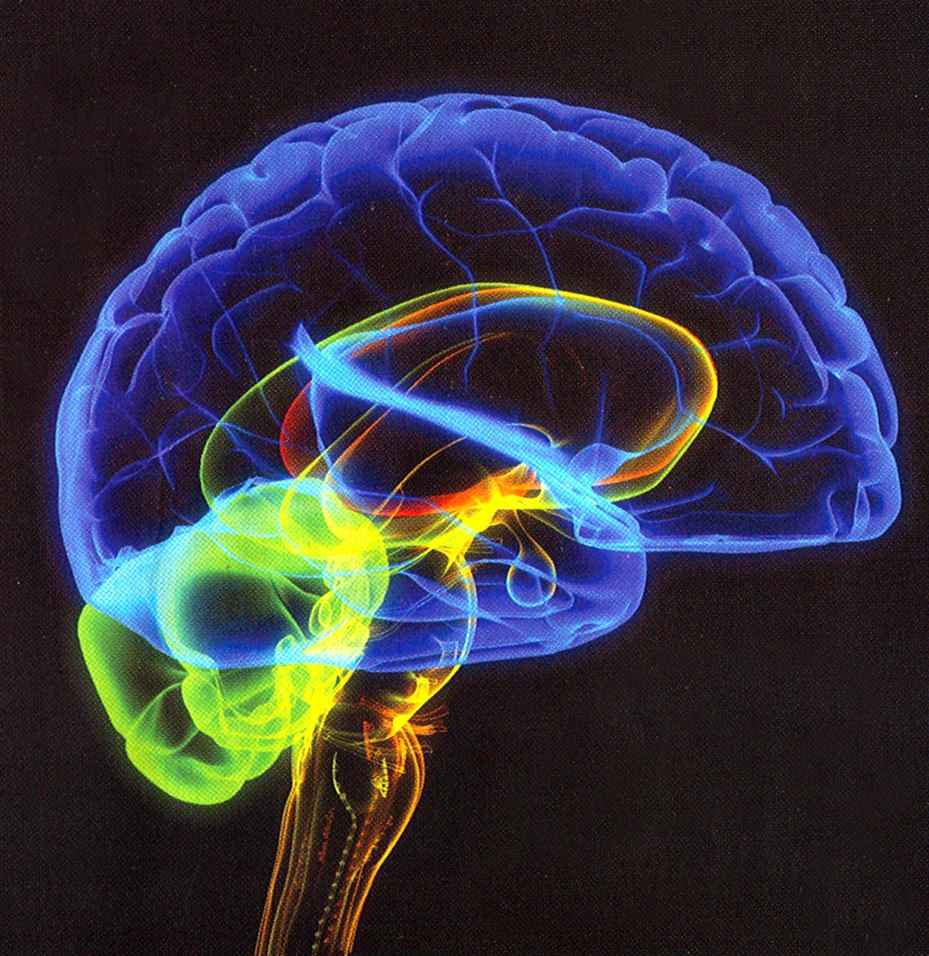
The three pounds inside our skulls are what we are and
can be: our uniquesness and potential.
Hippocrates traced our
sensory, nervous, and intellectual activities to regions of the brain. Millenniums later, neuroscientists are uncovering an
explosion of new information. We are getting brainier about our brains every day. It's mind-boggling.
"Journey to the Stars" dazzles at the Hayden Planetarium.
go to Journey to the Stars
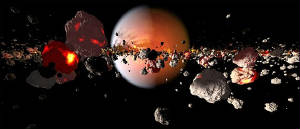
|
| "Cosmic Collisions" |
go to Colliding Galaxies
"All serious daring
starts within."
- Eudora Welty
|
 |
 |
 |
|
Our frazzled
brains.
Machine-human interactions are peaking, but
our constant connections may not be sustainable.
China, Taiwan and Korea have accepted the diagnosis of internet
addiction disorders and consider them a national health crises.
Recent surveys show that American addition numbers have reached
par with those in Asia. When the DSM (Diagnostic and Statistical Manual of Mental Disorders) is released in 2013 it will include,
for the first time, a category for human-machine interaction disorders.
Newsweek writer Tony Dokoupil says
"research makes it clear that the Internet is not ‘just’ another delivery system– but one that is creating
a whole new mental environment– a digital state of nature where the human mind becomes a spinning instrument panel.
Few users survive unscathed."
Susan Greenfield,
pharmacology professor at Oxford, calls the
issue as important and as unprecedented as climate change. She warns the "the digital culture is rewiring us– and not
for the better. Users are in denial, sleepwalking into these technologies and ending up like glassy-eyed zombies."
Peter Whybrow, neuroscientist
at UCLA equates the computer to ‘electronic cocaine’ saying that it can fuel cycles of mania followed by depression.
He is the author of "American Mania: When More is Not Enough."
Nicholas Carr, author of
"The Shallows: What the Internet is Doing to Our Brains," worries about the web’s effect of anxiety and compulsion
on cognition, that is. . . seriously messing with our brains.
Psychologist Larry Rosen, author of
"iDisorder," has researched the phenomenon for decades. He says "the Net fosters our obsessions,
dependence, and stress reactions and even encourages insanity."
He cites the preponderance of research showing "a link between
Internet use, instant messaging, emailing, and chatting, with depression among adolescents.
Wow, this is heavy stuff, but it gets worse. Ultra-web users are
prone to mental breakdowns and maniacal behavior. That trumps ADD abd OCD. Some have died of blood clots from sitting too
long.
Smart-phone users often go online before they get out of bed,
which is reminiscent of chain-smoking. Clearly there is something about the medium that is addictive.
In recent clinical experiments, over-digitized minds scanned like those of drug addicts.
Elias Aboujaoude, author of "Virtually
You," directs the Obsessive Compulsive Disorder and Impulse Control Disorders clinics at Stanford’s School of
medicine. So he sees the fallout of the Web’s irresistible allure.
"There’s little doubt that we’ve
become more compulsive." He is studying cases in which the digital world may support extreme forms of mental illness.
He finds that some ‘digital selves’ can be counted as legitimate alter-egos as in DSM (Dissociative Identity Disorder)
and multiple personalities. Scary stuff.
Judith Donath, media scholar at MIT,
says we may appear to be choosing to use this technology, but in fact we are being dragged to it. She told Scientific American
that "Every ping could be a social, sexual, or professional opportunity, and we get a mini-reward, a squirt of dopamine, for
answering the bell.
These rewards serve as jolts of energy that
recharge the compulsion engine, much like the frisson a gambler receives as a new card hits the table. Cumulatively,
the effect is potent and hard to resist."
Gary Small, head of UCLA’s Memory
and Aging Research Center, was the first to document changes in the brain, showing fundamentally altered
prefrontal cortexes, as a result of even moderate Internet use. Every respected scientific study published since has
found the same result.
Chinese researches have found ‘abnormal
white matter,’ essentially extra nerve cells built for speed, in the areas charged with attention, control, and
executive function. Similar results were found in the brains of video-game addicts.
The results are structural abnormalities in
gray matter. Typically there is a 10-20 percent shrinkage in the area of the brain responsible for processing of speech,
memory, motor control, emotion, sensory and other information. Worse yet, the shrinkage continues over time could result in
brain atrophy. atrophy.
Sherry Turkle, psychologist
at MIT has written "Alone Together." She interviewed 450 people in their teens and 20's about their
lives online. Although she was once a tech fan, writing articles for Wired, she now reveals "a sad, stressed-out world of
people coated in Dorito dust and locked in a dystopian relationship with their machines."
The evaporation of a genuine self also
occurred among the high-school and college-age kids the Turkle interviewed. They were struggling with their digital identities
and "FOMO" (fear of missing out), living in public with their webcam on– recorded and ‘mockable.’
Most felt defined by their profiles and posts. The overall thinking
was that ‘real life’ was just another window– and not the best one. Kids are consumed by their digital Ids
at an age when their actual Ids are in flux.
Researchers at Tel Aviv University
have published documented cases of ‘Internet-related psychosis" and have put the medical community on alert, concluding
that " Spiraling use of the internet and its potential involvement in psychopathology are new consequences of our times."
We all become overwhelmed with the velocity of our
lives from time to time, but that doesn’t explain why America runs on Xanax and other anti-anxiety drugs. The ego burst
of multi-tasking and the onslaught of tweets, texts, emails and texts don’t carry with them an order to ‘cave.’
Non-stop new media doesn’t, in itself, frazzle
brains. These are technological miracles that are ours to control. We don’t have to lose our minds.
go to Larry Rosen
go to Nicholas Carr

|
| Molecular Duo. |
Better Neuro-transmitters.
Yale scientists are investigating how our brain controls the amount
of food we eat and how much we sleep. Anthony van den Pol, professor of neurosurgery at the Yale School
of Medicine is heading up the research project.
The team has discovered a key cellular mechanissm that may help
the brain control how much we eat, what we weigh, and now much energy we have.
They found that the melanin-concentrating hormone
(MCH) neurons make lab animals eat more, sleep more, and have less energy. But by using the thyrotropin-releasing
hormone (TRH) as a neurotransmitter, there is reduced food intake and body weight, and increased physical activity.
Of course the pharmaceutical industry is eager to see the research
speeded up. Soon we may get a pill to give us better sleep, get slim, strong, and energetic. That would be a home run.
go to Yale School of Medicine
How do we learn?
In 1983 education theorist Howard
Gardner asked: "Can every sort of intelligence be measured with the tools we’ve been using for
the past century and more?" The answer, in his landmark book "Frames of Mind" was ‘no.’
And so a revolution began in the way educators are taught to teach, and
in how children learn. His landmark theory of multiple intelligences fractured the notion of "one intelligence fits all."
He broadened the spectrum by stating that each individual has inherent potential to learn in different ways.
Neuroscientists now say that of the six billion-plus human
brains now ‘living,’ there are no two alike. Each is different. Yet before Gardner, the common thinking was that
intelligence could be determined from one measuring stick. There was no controversy about standard testing, and kids in a
classroom were graded by a general norm.
"After" Gardner, teachers began to appreciate the differences in how
students learn. This led to then radical ideas like magnet schools.
Here are the seven types of intelligences Gardner first presented:
- Visual-spatial intelligence can solve problems
and retain information through manipulation of mental images and dimensional objects.
- Kinesthetic intelligence can use one’s
body to understand and express concepts.
- Musical intelligence can employ musical
patterns, rhythms, pitch, and timbre for cognition; can find expression by creating and performing music.
- Mathematical intelligence can logically analyze
problems, investigate issues in a scientific manner, and carry out numeric operations.
- Verbal-linguistic intelligence can use verbal
skills and have sensitivity to the sounds, meanings and rhythms of words.
- Intrapersonal intelligence can be aware of
and understand one’s own feelings, fears, and motivations.
- Interpersonal intelligencec can sense the
intentions, motivations and desires of others and work effectively in groups.
Natural intelligence cultivates learning through awareness and study of nature, using strategies such as classification
of plants, animals, and artifacts. (This is Garner's newly-added eighth category.)
Gardner, a professor of Cognition and Education at Harvard University
graduate school, says there are probably more types, but he doesn’t want to muddy the waters with more categories. There
is already enough controversy and misuse of his theories by school administrators, policy makers, and pop psychologists.
In his new book, "Intelligence Reframed,"
Gardner updates the evolution and changes in his theories (and introduces two more intelligences for discussion: existential
and naturalist). Yes, he wants the concept of intelligence to be broad, but not so absurdly that it includes every human virtue
and value.
He says that a basic set of seven or eight intelligences
is a unique trademark of the human species. This has huge implications for ideas about creativity, leadership, moral excellence,
and work in the future.
So, how do you learn? What’s your type of intelligence? And were you lucky enough to go to a school where they cared
enough to figure it out and offer direction?
"We
shall not cease from exploration. And the end of all our exploring
will be to arrive where we started and know the place for the first time." - T.S. Eliot
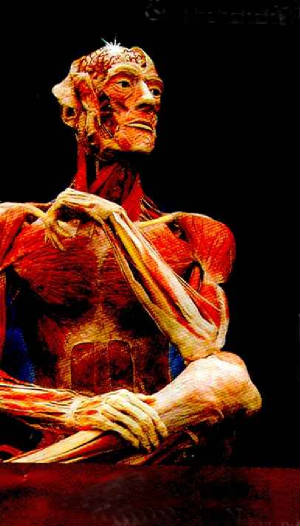
|
| Exhibit in Gunther von Hagens' "Body Worlds." |
Body
Worlds: Anatomical
wonders-- already viewed by 26 million people.
Dr. Gunther von Hagens developed
"plastination" in the 1970's and has been improving on it ever since.
His work is a boom for anatomy students,
medical science– and everyone who wants to better understand nature’s great marvel: ourselves.
His methods are precise and highly-evolved. To greatly
oversimplify: fluid and fatty tissues are replaced with acetone. When that evaporates, it's replaced with polymer solutions.
Forced vacuum impregnation is used to get liquid polymer into every single cell. It can take weeks to process an entire
body.
The tour exhibit is inspired by the latest advances
in medical research. "Mirror of Time" shows the arc of life from birth to old age. "Our Three Pound Gem" highlights the newest
neuroscience findings, showing normal brain development, diseases and disorders. Hearts show how our four-chamber muscle nourishes,
regulates, and sustains life. Athletic and sedentarybodies are compared-- and there is much more that deserves close attention
and appreciation.
The bodies are authentic. They belonged to generous
people who declared during their lifetime a wish for their remains to undergo plastination for the benefit of science and
education.
more on Dr. Gunther von Hagens
 |
 |
|
Freedom of thought
requires thinking.
|
|
 |
 |
Humans are 'natural-born' cyborgs, and the internet is our giant extended
mind.
go to Mind Link
Enjoy Video Lectures
From Philosophy to Quantum Physics and hundreds of disciplines in between, you'll surely find topics of interest.
There are thousands of on-screen lectures from super-scholars at top-tier universities available at no cost, at any time you
wish, on the internet. No matriculation required. Take advantage of the opportunity. Go look.
go to lectures at Academic Earth
go to riveting talks by remarkable people at TED
go to scholar's lectures at You-Tube Education
Knowledge News is a reliable purveyer of
information we need to know to participate in throughtful conversations about our world. Get acquainted.
go to Every Learner

|
| From Nova's "The Elegant Universe." |
It's a String Thing.
Some theorists believe that every particle contains a vibrating, oscillating,
dancing filament, called a "string." String theory adds a microscopic layer of information to
earlier knowledge about atoms, protons, neutrons, electrons, and quarks. NOVA's program, "The Elegant
Universe" makes these ideas acccessible.
The 3-hour program may be seen online. First hour: Einstein's
Dream. Second hour: String's the Thing. Third hour: The 11th Dimension.
Each hour is divided into 8 chapters. You can pick and choose any part you want to watch.
go to NOVA's "The Elegant Universe"
The Rhythms of Our Minds:
Our minds don't run on Eastern or Pacific Standard Time. The cells
in our brain that regulate the timing of our behavior aren't tuned to the toll of Big Ben. Our bodies' circadian rhythmic
cycles have a unique neurology of their own. Health and lives can be much improved if we 'swing and sway' to those rhythms.
On the link below you can listen to a discussion among top physicians
about our BODY CLOCKS. Presentation by The Infinite Mind series on PBS.
go to Body Clocks on The Infinite Mind
"To quiet oneself one must first waste a little
time."
- Elizabeth Bower
"The test of a first-rate intelligence is the ability
to hold two opposing ideas in mind at the same time and still retain the ability to function."
- F. Scott Fitzgerald
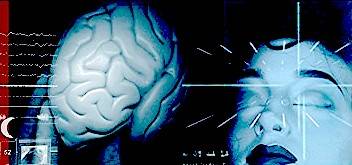
|
| Studying mysteries of the sleeping brain. |
Sleep on it.
Scientists began wondering why we sleep a mere hundred
years ago. But they came up with nothing, nada– finding only an annihilation of consciousness. In the fifties the phenomena
of REM was recorded in studies, but beyond that they "hit a wall." It wasn’t till 1994 that neuroscientists caught on
to the brilliance and complexity of the sleeping brain.
So what occurs when we enter the wonder-world of sleep?
A lot. When we fall asleep our brain goes into purposeful action. A secretive intelligence comes out to play, and work–
in a way that makes our waking life possible.
To simplify current research, our sleeping brain has four
general phases: "stage 1," a light sleep with rapid eye movement (REM); "stage 2," an intermediate, "medium" sleep; and "stages
3 and 4," deep and very deep slow-wave sleep.
In 1994 a team led by Avi Karni found that depriving people
of REM sleep undermined their memory of patterns they had learned the day before. (Millions of people who take drugs
that suppress REM report serious memory problems.)
In testing students, just a nap, including stages 1 and
3, accounted for higher scores in pattern recognition, grammar, and chess. And so the field woke up to the long-neglected
area of learning and memory.
In 2003 researchers at Harvard and UCSD discriminated between
a wide variety of textured patterns in sleep. They found a strong connection between "stage 2" sleep and improvement in learning
motor tasks– like mastering a guitar, keyboard, or a hockey stick.
The implication is that it’s better for performers
to stay up late than to get up early. But with all the night-time fireworks, no one yet knows how the differences between
night owls and early birds affect sleep-learning.
The sleeping brain actively consolidates the day’s
streaming video of information. A "good" night’s sleep involves activity in all four stages.
According to a new paper by Dr. Matthew Wilson at MIT the
hippocampus is spatially sensitive when firing up pairs of neurons. Computers can record the cells’ firing pattern in
real time and broadcast it over speakers. "I literally hear the background music of the brain," says Wilson.
Dr. Subimal Datta at Boston U’s medical school describes
a chemical bath during sleep unlike any during waking. He says:
"During waking we have a thousand things happening
at once, the library is filling up, and we can’t possibly process it all. While awake the brain also gathers valuable
information subconsciously. It’s during sleep that we have this special condition to clear away this overload and store
what is important."
While asleep our brains mix, match, and juggle the memory
traces, looking for hidden connections to help make sense of the world.
Our awake realities are cut up, reordered, sifted, and
shuffled again– in a kaleidoscope of distilled experiences. Sleep brings us new insights into our life and work, solutions
to problems, confident decisions-- and often brings us the golden gift of inspiration.
Happy dreams.
The Neurosciences Institute has
isolated genetic factors of aggressive behavior... found how the brain helps us navigate the world...
showed connections between speech and music... developed the most extensive
computer simulation of the cerbral cortex-- and more and more every day. Exciting and fun.
more Brain Facts from the NI
There is no "off" position on the genius switch.
 |
 |
"People
rarely make use of the freedom they have-- for example, freedom of thought-- instead they demand freedom of speech as compensation."
From the journals of S°ren
Kierkegaard.
|
|
 |
 |
"Most of the important things that a human being
ought to know cannot be comprehended in youth."
- Robert Hutchins, Pres., Univ. of Chicago
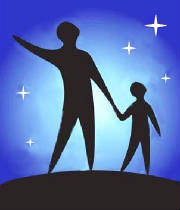
|
| Logo for International Year of Astronomy. |
Chronic anxiety is the pernicious
illness of our times. We need to get a grip on our minds, de-stress our neurosomatic systems, listen to our bodies--
and breathe. We are the 'canaries in the mine' in a brutal survival experiment. We must tend to our brains.
"The trouble with the
world is that the stupid are cocksure and the intelligent are full of doubt."
- Bertrand Russell
Come to your senses!
Take the 20-question "Sense Test" on BBC's science website:
go to Puzzability
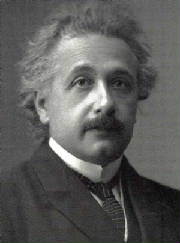
|
| Albert Einstein, 1921 |
"The eternal mystery of the world is its comprehensibility."
"Everything should be made as simple as possible,
but not simpler."
- Albert Einstein
Of course society needs both grinds
and rebels-- Einstein was clearly the later. Early on he was unruly in the classroom and had a distaste for
dogma and rote learning.
His off-beat creativity drove academics
nuts. In college he alienated his professors and was unable to get a doctorate or a teaching job. He was impertinent enough
to discard the notion of absolute time-- one of the sacred tenets of classical physics since Newton.
He famously said "Imagination is more
important than knowledge." What a guy.
The World Year of Physics
is the anniversary of the "miraculous year." Annus mirabilis!
For centuries, scientists believed that matter and energy could never
be destroyed. Before 1905 the law of conservation of energy and the law of conservation of mass were two inviolate principles
of science. Einstein showed that these laws were fallible and needed to be reconciled into a single theory unifying mass and
energy.
In 1905 Albert Einstein wrote five revolutionary papers
that altered our understanding of the nature of light and established the concept of relativity and the existence of atoms
and molecules.
March 17, 1905: light quanta hypothesis.
April 30, 1905: existence of atoms.
May 11, 1905: Brownian motion.
June 30, 1905: connected electromagnetic theory and motion.
September 27, 1905: theory on special relativity.
Three months after his paper on special relativity, he applied his theory
to mass and energy, and formulated the famous equation E=mc▓
He showed that states of energy (E) and mass (m) are equivalent, where
c is the velocity of light.
He theorized that mass and energy are different forms of
the same entity and can be changed from one to the other. Since c is a very large number (299,792,458 m/s) a small amount
of mass can be converted into an enormous amount of energy.
Any object in the universe theoretically can be changed into energy.
Nuclear fusion reaction, for example, converts the sun’s mass into energy.
All the mass decreases and energy increases furing the process; the two
are muitually conceived as one entity.
Einstein’s theory expresses this relationship through a new law
of conservation of mass and energy. He formulated the equation in 1905, but it was not til the 1930's that the conversion
of mass into energy was confirmed through the study of nuclear reaction. E=mc▓ explained why the sun shines
(and to Einstein’s later despair, laid the groundwork for the physics that led to the atomic bomb.)
"My life is a simple thing that would interest no one.
It is a known fact that I was born, and that is all that is necessary." - Albert Einstein
|
 |
|
|
|

